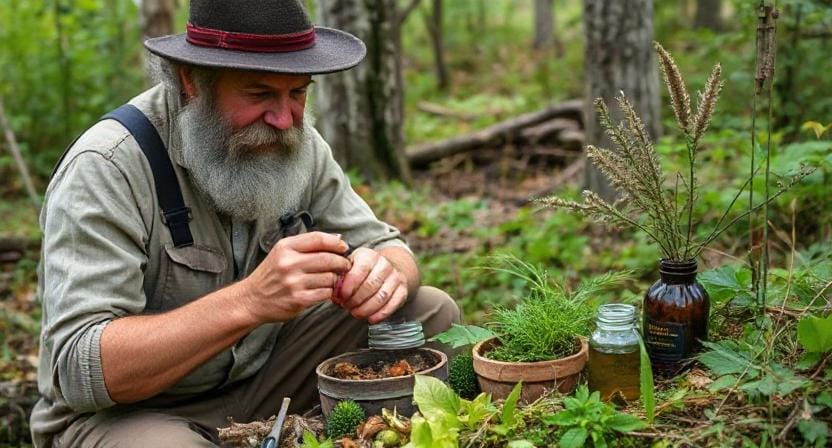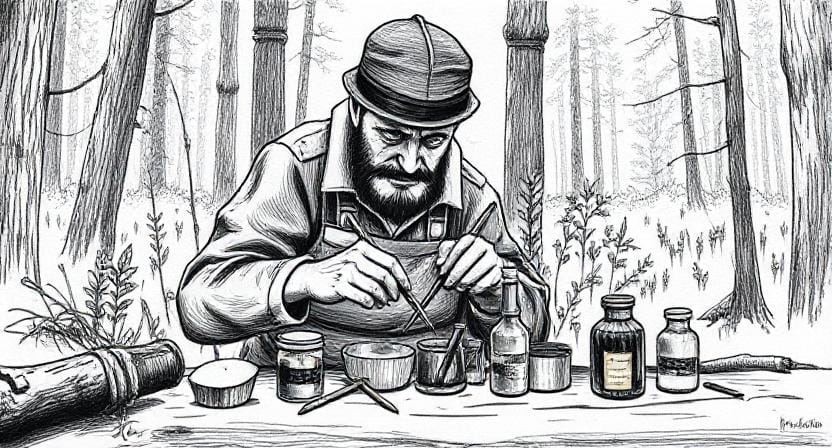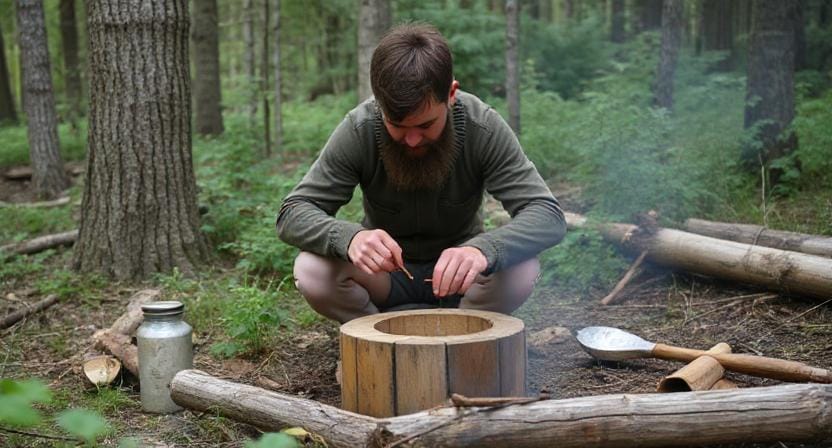Please Note: This post may contain affiliate links. If you click one of them, we may receive a commission at no extra cost to you. As an Amazon Associate, I earn from qualifying purchases.
Last Updated on November 1, 2025 by Kevin Collier

Top Takeaways and Key Concepts
- Learn to identify safe, beneficial herbs before using or harvesting them.
- Create tinctures by steeping herbs in alcohol for two weeks, shaking often.
- Make soothing salves with herb-infused oils and melted beeswax for healing.
- Build a balanced first aid kit combining natural and traditional remedies.
- Keep learning through books, workshops, and trusted herbal medicine resources.
Picture this: the world has gone a bit wild. Maybe you’re stuck in a place where the internet is just a legend. Remember that time you tried to recall your high school locker combination? Yeah, frustrating, right? Now you're wondering how to soothe a headache or a sore throat without running to the store.
Good news! You can make your own medicine. For real! With just a little bit of knowledge—and maybe a sprinkle of bravery—you can turn your kitchen into a mini apothecary. Sounds fun, right?
Imagine turning fresh herbs from your garden into soothing teas or tasty syrups. You could grab some ginger and honey for that scratchy throat. Or how about making a calming lavender balm with flowers from the garden? It’s like bringing a bit of magic to your home.
Think of it as a cool DIY project. Instead of making those macramé plant hangers (which are nice but kinda complicated), you’re crafting something that helps you feel better. It’s rewarding. Every time you use your homemade remedy, you’ll feel like a little wizard.
It doesn’t have to be super fancy. Just a few simple ingredients can work wonders. Dandelions, for instance. They’re often overlooked, but they can help with digestion and make a yummy tea. Who knew?
As you dive into this, you’ll find a whole world of plants out there. The best part? You get to connect with nature a bit more. It’s like having conversations with the earth. A little sniff here, a taste there—you'll start to recognize what works for you.
It's okay if it feels a little goofy or unsure at times. Everyone has to start somewhere. Accepting this challenge will make you stronger and more independent. And let's be honest: who wouldn't want to hear a wonderful story about how you manufactured your own medicine?
So, be ready to work with those herbs and get crafty! You will make something nice for you just from your home. It's also a great way to spend time with friends or family. Just think about how nice it would be to share your homemade cures over coffee. How cool would that be?
Contents of This Page
*** Shop for Survival Gear - Tools - Kits ***
Survival Gear - Bags and Backpacks - Knives - Boots/Footwear - Communication
Outdoor Cooking - Gloves - Hydration - Dry Boxes - Water Filtration Systems
Tents - Sleeping Bags - First Aid Kits - Multi-Tools - Flashlights - Fire Starters
Navigation - Survival Food - Night Vision - Headlamps - Stun Guns - Binoculars
Understanding Herbal Remedies: Nature's Pharmacy

Let’s start with the basics: what exactly are herbal remedies? Imagine nature's version of a pharmacy, minus the fluorescent lights and awkward small talk with the cashier. Plants have been used for centuries to treat ailments ranging from headaches to heartburn, so why not tap into that wisdom?
By the way, before you start foraging like a raccoon on a mission, it's crucial to know which plants are safe. Some plants can make you feel great—while others could send you on an unexpected trip to “not-so-happy land.”
For instance, peppermint is fantastic for soothing stomach issues while dandelion leaves can help detoxify your liver. Who knew those pesky weeds had such hidden talents?
When gathering herbs, consider keeping a journal (yes, I know journaling sounds like something you'd do at summer camp). Jot down what you find and how it helps; this will keep your herbal adventures organized—and prevent any accidental poison ivy incidents!
Crafting Tinctures: The Magic Elixir

Now that you've got some herbs in hand, let’s dive into making tinctures. A tincture is simply an alcohol-based extract made from herbs. Think of it as nature's concentrated medicine—but without the side effects of binge-watching reality TV shows.
To create a tincture, all you need are dried herbs (or fresh if you're feeling fancy), high-proof alcohol (like vodka—sorry kids!), and some jars. Here’s how it works: fill your jar halfway with herbs, then pour in enough alcohol to cover them completely.
Seal it tight and let it steep in a cool dark place for about two weeks—just long enough for those herbs to release their magical properties.
Every few days, give it a shake! This isn't just exercise; it's essential for mixing things up—literally! After two weeks, strain out the solids using cheesecloth or an old t-shirt (don’t worry; no one has to know).
What you'll have left is liquid gold—well, more like herbal-infused vodka—but we’ll call it liquid gold because who doesn’t want that?
Making Salves: Soothe Those Scrapes

Next up on our homemade medicine tour is salve-making—a fancy word for ointment designed to soothe cuts and scrapes. You’ll want beeswax as your base ingredient because nothing says “I’m prepared” quite like having beeswax hanging around.
To make salve, start by infusing oil with dried herbs such as calendula or chamomile. Simply heat olive oil gently on the stove and add your chosen herb until fragrant (and don't forget about those essential safety precautions; no frying yourself while multitasking!).
Let this simmer over low heat for about 30 minutes before straining out the herb bits.
Once you've got your infused oil ready to go, melt equal parts beeswax in another pot over low heat until it's gooey goodness. Combine this melted wax with your infused oil until you reach desired consistency—a bit thicker than pancake batter should do!
Pour into small containers or lip balm tubes once cooled slightly but still pourable—and voilà! You’ve created an all-natural first aid solution fit for any apocalypse survivor—or just someone who regularly trips over their own feet.
Assembling Your First Aid Kit: The Essentials

Having homemade medicines is great but pairing them with traditional first aid supplies makes even more sense! Let’s see…you’ll want adhesive bandages (because life happens), antiseptic wipes (for when dirt isn’t doing its job), gauze pads (to stop bleeding unless you're planning on starring in an action movie), medical tape (to hold everything together), tweezers (for splinters—not eyebrows!), scissors (which also double as self-defense weapons if necessary), and pain relievers like ibuprofen or acetaminophen.
Interestingly enough, creating a first aid kit can be akin to assembling furniture from IKEA—you’ll need patience and maybe some questionable vocabulary choices along the way! But trust me; once you've got everything assembled neatly in one location labeled “DO NOT TOUCH UNLESS BLEEDING,” you'll feel more confident facing whatever comes next.
Learning More About Natural Remedies
Today we've spoken a lot about how to make medicine from scratch. That's pretty cool, right? But there is still so much more to learn! You might want to read some literature about herbalism. There are a lot of really good ones out there. You might even find one with pretty photographs of herbs. You can almost smell them through the pages!
Imagine attending to a workshop in your area. There you are, talking to people who genuinely know what they're talking about. They probably gathered dandelions and made flower crowns out of them. Isn't it cute? You'll not only learn, but you'll also sense a nice, fuzzy connection with other people who care about the same topics.
Don't forget about the web. Oh my gosh, it's like having a huge library right in front of you! There are a lot of websites that have free advice on natural cures. Wow! You could look into cures that have been passed down via families for years. Think about the stories that go with those recipes.
You can get advice on everything, from drinks that help you sleep to creams that get rid of annoying rashes. There is probably a solution out there for whatever you need. You might discover a new plant that you've never heard of before. How much fun is that?
Take your time while you look through these materials. Have fun as you learn. It's like a pleasant search for information. Have a notebook on hand to write down interesting thoughts. You never know when a bit of knowledge will come in helpful.
So sit back, relax, and have a drink. No matter if you're reading a book, going to a workshop, or looking at a website, remember that every piece of information you learn makes you stronger and better equipped. You can do this!
Frequently Asked Questions
Why is plant identification important before making herbal medicine?
Correct identification prevents harmful plant use and ensures you are using herbs with proven beneficial properties.
How long does a tincture usually take to make?
Tinctures typically steep for about two weeks in alcohol, with frequent shaking for best extraction.
What ingredients are needed to make a salve?
Most salves use herb-infused oil and melted beeswax, combined to create a smooth, spreadable healing ointment.
Can homemade remedies replace all store-bought medications?
No. Natural medicine can help, but a balanced first aid kit should include both herbal and conventional medical supplies.
Is it safe to experiment with different herbs?
Only use plants you have identified correctly and research dosage guidance before experimenting with new herbs.
What should every homemade first aid kit include?
Herbal tinctures and salves plus essentials like bandages, antiseptic wipes, gauze, tape, and basic pain relievers.
How can someone continue learning herbal medicine skills?
Use books, workshops, and credible herbal education resources to expand knowledge and refine skills over time.
Suggested Resources:
Herbal Medicine: A Practical Guide
https://www.ncbi.nlm.nih.gov/pmc/articles/PMC3708244/
The Complete Herbal Handbook for Farm & Stable
https://www.amazon.com/Complete-Herbal-Handbook-Farm-Stable/dp/1856266765
How To Make Herbal Infused Oils
https://www.herbwisdom.com/herbal-infused-oils.html

Kevin Collier is a seasoned survivalist and expert in prepping and homesteading, contributing to WiseSurvive.com. With a deep-rooted passion for self-sufficiency and outdoor survival skills, Kevin shares practical advice, strategies, and resources to help individuals prepare for any challenge. His informative articles cover a range of topics, from essential survival techniques to sustainable living practices, empowering readers to thrive in any situation. Whether you're a novice or a seasoned prepper, Kevin's insights will inspire you to take charge of your readiness and build resilience for the future.




